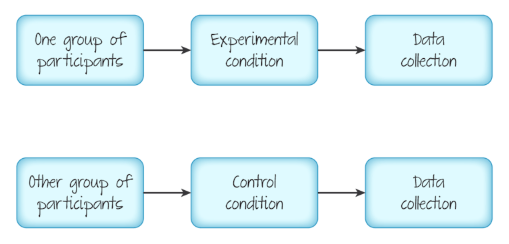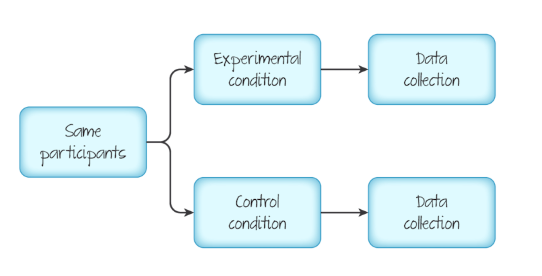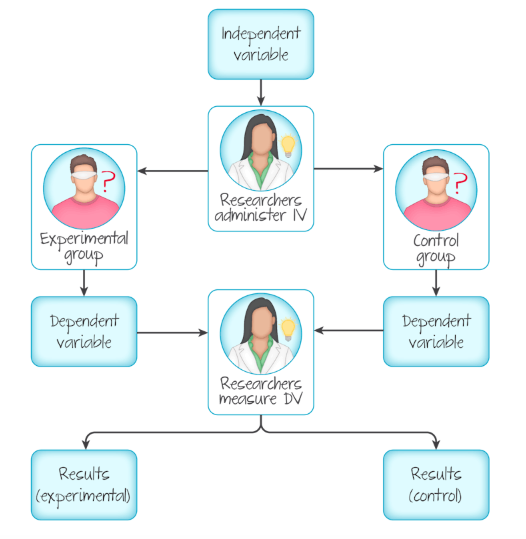1A - elements of researching behaviour
1/67
Earn XP
Description and Tags
Name | Mastery | Learn | Test | Matching | Spaced |
|---|
No study sessions yet.
68 Terms
hypothesis
a tentative statement or prediction that proposes an explanation for some psychological phenomenon
a hypothesis must be both….
testable and falsifiable
alternative hypothesis (H1)
predicts an effect
(a manipulated variable is expected to cause some change in a measured variable)
null hypothesis (H0)
predicts no effect
(manipulated variable causes no change in the measured variable - ie, any change is due to chance)
*NOT the opposite of the alternative hypothesis
one-tailed hypothesis
predicts effect in one direction (one of either positive or negative)
two-tailed hypothesis
predicts an effect in either direction (can cause both positive and negative)
significance testing
one of H1 or H0 is accepted and the other rejected, depending on statistical analysis results that determine if results are statistically significant or occurred by chance
hypothesis testing
H1 and H0 are compared using statistical error rates and collected data, supporting one hypothesis over the other
reification
defining an abstract concept as a real/concrete variable. *CANNOT DO
quantitative variables
a type of variable that is a numerically measurable quantity
categorical variables
a type of variable where qualities can be used to assign categories to individuals/groups
operationalised variables
variables that have been expressed specifically in terms of how they will be measured
variables that are categorical / not already expressed in quantitative terms can still be operationalised by…..
quantifying them on a scale
independent variable
the factor or variable being manipulated by the researcher
aka the CAUSE
dependent variable
the factor or variable being measured by the researcher
aka the EFFECT
the two key components of a psychological theory
must describe a behaviour
makes a prediction about future behaviours
TEACUP acronym for evaluating theories
Testable - has to also be falsifiable so that it can be tested
Empirical support - supporting evidence that is reliable and can be replicated
Application - can be applied to various different situations or improves a specific behaviour
Clearly defined variables - can be reliably measured
Unbiased - not androcentric (gender bias) or ethnocentric (culture bias)
Predicts behaviour - has a high predictive validity
two types of sampling methods
probability and non-probability
types of probability sampling
simple random , stratified , systematic
types of non-probability sampling
convenience / opportunity , purposive , snowball
what does the incorrect sampling of participants affect?
the validity of a study
target population
the wider group of people to whom a study’s results can be generalised
typically include a set of traits/characteristics that are relevant to the research
sampling frame
the accessible portion of the target population that researchers can identify
sample
those from the population who actually participate in a study
random selection
every member of a population has an equal chance of being chosen for participation
*only possible when a researcher has access to an ENTIRE population, which is why it is rare that psychological research draws a truly random sample
the only way to obtain a properly representative sample is through….
probability sampling methods using random selection
how to obtain a simple random sample
organise the sampling frame to identify every member of the accessible population
use a statistically random method to select the sample (eg: random number generator)
what is the challenge for simple random sampling?
it is often not a viable technique for many psychological studies as EVERY member of a target population may not always be identifiable / accessible
how to obtain a sample using stratified sampling
identify strata (key subgroups within a target population)
a simple random sample is taken from each strata to make the overall sample
*effective for small populations with known characteristics
benefit of stratified sampling
allows for a more representative sample as all important subgroups are included
disadvantages of stratified random samples
prone to researcher bias due to how a researcher may define strata
if members of a population belong to 2+ strata, stratified sampling becomes ineffective
what is a proportionate sample drawn using stratified sampling?
when the sample group contains a number of participants from each subgroup that is relative to their fraction of the overall population
what is a disproportionate sample drawn using stratified sampling?
when certain strata are weighed more heavily than their fraction of the population, resulting in overrepresentation of some subgroups
how to obtain a systematic random sample
randomly number members in the population
determine sample size
calculate k using the following formula
k = N / n , where N = population size / n = sample size / k = interval value
draw a random number between zero and k
from the drawn number, every kth participant is chosen for the sample
disadvantages of systematic sampling
every kth member may share similar characteristics, so the sample may not be representative
the technique is based on the assumption that population sources are randomly organised to begin with
can data collected using non probability sampling methods be analysed using inferential statistics?
no !!!
convenience / opportunity sampling
sampling frames that are readily available , nearby , and willing to participate
**sample is selected by researchers
disadvantage of convenience sampling
technique is biased, so samples drawn are not statistically generalisable to the target population
*results may still be transferable (?)
volunteer sampling
sample obtained/chosen by people who choose to participate in the study themselves (typically through advertisements)
volunteeers accepted until researcher has adequate participants
disadvantage of volunteer sampling
biased technique, not representative of target population
purposive sampling
participants that are chosen for a sample according to predetermined criteria that is relevant to the research
*sample sizes are determined by theoretical saturation ; the point at which additional / new data will not provide additional insight into the research question
disadvantage of purposive sampling
tends to overrepresent sub groups in the population
when is purposive sampling most effective?
when data review and analysis are completed as data is being collected
snowball sampling
where participants already involved in a study are asked to recruit / recommend others who meet the selection criteria
*type of purposive sampling
**typically used when target population is rare / hard to find / hidden
disadvantages of snowball sampling
anonymity of participants is often lost
unlikely to yield a representative sample
the two types of groups in a research design
experimental group (one or more - group subject to manipulation of the IV)
control group (typically exposed to a placebo instead of the IV to gather baseline data)
independent measures (between-subject design)
two separate groups of participants , where each participant is tested on only one condition of the experiment

demand characteristics
participants of a study figuring out the aim/hypothesis, and changing their behaviour to deliberately please/confound it
participant variables
differing personal characteristics of individuals across different groups that may affect the data
*a type of EV
strengths of independent measures
prevents order effects
prevents demand characteristics
participants are more likely to complete the study ; less risk of losing data
more time efficient ; experimental and control groups can be researched simultaneously
weaknesses of independent measures
affected by participant variables
greater number of participants required
random assignment conditions
each participant has an equal chance of being assigned to each experimental condition
each participant’s assignment to either condition is independent of other participants
*mitigates researcher bias affecting allocation
repeated measures (within subject design)
each participant is exposed to all experimental conditions ; each participant yields at least two pieces of data

order effects
the effect of participation in one condition of the experiment then effects participant behaviour in a later condition
*when not controlled, these become CVs
types of order effects
practise / learning — participants perform better in later conditions bc they have learned the task in earlier conditions
fatigue / boredom — participants perform worse in later conditions bc they are tired/bored from the earlier ones
context — testing in earlier conditions may influence how participants interpret tasks in later conditions
*when not controlled, these become CVs
counterbalancing
when a sample is split in half, with one half completing conditions in the order A-B and the other half in the order BA
a more complex version is having all participants complete the conditions in the order A-B-B-A, and taking the mean score across both trials
*counterbalancing mitigates order effects’ impact on results by applying them to both sets of data
ways to mitigate order effects
counter balancing
including a time lag between conditions (so that order effects can wear off)
randomising stimulus material
randomising the order in which conditions are presented to each participant
strengths of repeated measures
requires fewer participants
reduces impact of participant variables as they are the same for all groups
weaknesses of repeated measures
subject to the impact of order effects
subject to the impact of demand characteristics
requires more time from each participant
matched pair design
participants sampled are similar in a range of specific characteristics relevant to the study, and each partner is randomly assigned to the control/experimental group
strengths of matched pair designs
controls impact of participant variables
avoids order effects
weaknesses of matched pair designs
highly time consuming
only identical twins allow for exactly matched pairs
high risk of lost data ; if one participant drops out, the partner’s data also becomes unusable
standardisation
the elimination or control over an variable or factor other than the IV that may affect the results of a study
elements of a standardised procedure
standardised environment (location)
standardised instructions
standardised materials and tests (researchers also trained in administration and scoring)
standardised procedure (researcher-participant interaction)
single-blind control
when the participant is unaware of whether they are in the control or experimental group
*reduces influence of participant expectancies

double-blind control
when the participant’s allocation to the experimental/control group is hidden from both researchers AND the participant
*reduces influence of participant expectancies
ethical considerations in psychological research
informed consent
protection of participants
right to withdrawal
confidentiality and anonymity
deception
debriefing
ethical considerations in reporting results
confidentiality and anonymity
stigmatisation
scholarly integrity